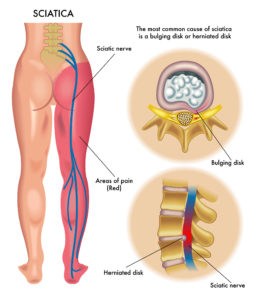Using the analogy of the jelly doughnut is an easy way to visualize the more complex anatomy of spinal discs.
Simply put, the spinal discs are made up of two main parts- the jelly-like disc center called the nucleus pulposus, and the outer most layer called the annulus fibrosis.
These two parts help the discs move and protect the vertebrae.
Bulging Disc

When someone has a bulging disc, the outer layer of their spinal disc extends outside their vertebral space, resembling a hamburger that’s too big for its bun (that’s right, another fast food analogy).
Research indicates that more than 50 out of 100 people who had a pain-free back and had a magnetic resonance imaging (MRI) tested positive for a bulging disk.
A bulging disc is considered to be a common part of the disc’s aging process and usually doesn’t cause any pain.
Herniated Disc
A slipped or herniated disc is a whole other ball game. This happens when the tough outer layer of the disc degenerates, or sustains a trauma and cracks, allowing some of the nucleus pulposa to protrude out of the disc into the spinal canal.
Herniations are most common in the fourth and fifth lumbar vertebrae. This weak spot lies directly under the spinal nerve root, putting direct pressure on the nerves causing radiating pain, tingling, and numbness down the leg. It’s important to note that not all herniated discs cause painful symptoms.
Can Massage Help Herniated Discs?
Massage therapy isn’t the magic pill, and can’t reverse the curse of a current disc herniation. However, massage CAN be extremely helpful in reducing pain by loosening the tight low back muscles that compress and pinch the underlying discs.
As with any potentially serious medical condition, I always recommend getting the thumbs up from a doctor before booking a massage.
Source: PubMed Health

